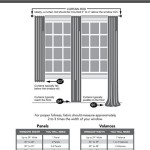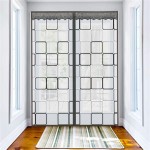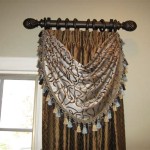Determining the Optimal Distance Between Curtains and Windows
Achieving the right balance between aesthetics and functionality in interior design often involves careful consideration of seemingly minor details. One such detail is the distance between curtains and windows. The spacing significantly impacts how curtains hang, how much light they block, and even how well they insulate a room. Understanding the factors influencing this distance is crucial for homeowners and interior designers aiming to create visually appealing and energy-efficient living spaces.
Several elements contribute to the ideal distance between curtains and windows. These include the type of curtains, the window size and architecture, the desired level of light control, and the overall room aesthetic. Failing to consider these factors can lead to suboptimal results, such as curtains that don't hang properly, insufficient light blockage, or a visually unbalanced appearance. This article delves into the key considerations for determining the appropriate distance between curtains and windows for various scenarios.
Curtain Type and Header Style
The style of the curtain header plays a crucial role in determining the optimal distance from the window. Different header styles require varying amounts of space to hang properly and achieve their intended look. For instance, curtains with grommet tops typically need more space above the window frame than those with rod pockets or pleated headers.
Grommet-top curtains, characterized by metal rings sewn into the top edge, create a series of evenly spaced folds when hung. To ensure the grommets move freely along the rod and that the curtains hang with the desired drape, a sufficient gap between the rod and the top of the window frame is essential. A general guideline is to allow at least 4 to 6 inches of space above the window frame for grommet-top curtains. This allows the fabric to fall gracefully and avoids a cramped or bunched appearance.
Rod-pocket curtains, on the other hand, have a sewn-in pocket at the top through which the curtain rod is inserted. These curtains often require less space above the window frame compared to grommet-top styles. A 2 to 4-inch gap is usually sufficient to accommodate the rod and allow the curtains to hang properly. However, consider the depth of the rod pocket itself. A deeper pocket may necessitate a slightly larger gap to prevent the curtain rod from rubbing against the window frame.
Pleated curtains, including pinch-pleat, goblet-pleat, and French-pleat styles, often require more precise measurements. These curtains are typically hung using drapery hooks that attach to a traverse rod or rings. The distance from the top of the window frame to the rod depends on the desired length of the curtain and the specific pleat style. Generally, allowing for 4 to 8 inches above the window frame can accommodate pleated curtains, but consulting the specific instructions for the chosen pleat style is crucial for accurate placement.
Beyond the header style, the overall weight and thickness of the curtain fabric also influence the optimal distance. Heavier fabrics, such as blackout curtains or thick velvet, may require stronger rods and more robust brackets. Ensuring the rod is securely mounted and can support the weight of the curtains is paramount for safety and longevity. A slightly larger gap above the window frame may be necessary to accommodate heavier hardware and ensure the curtains hang without sagging.
Window Size and Architectural Considerations
The size and shape of the window, as well as the surrounding architectural features, significantly impact the visual effect of the curtain placement. Taller windows generally benefit from a greater distance between the curtains and the window frame, creating a sense of height and grandeur. Conversely, smaller windows may appear disproportionate if the curtains are hung too far above them.
For standard-sized windows, a general rule of thumb is to hang the curtain rod approximately 4 to 6 inches above the top of the window frame. This distance allows the curtains to extend beyond the window, creating the illusion of a larger window and maximizing the amount of light blocked when the curtains are closed. However, the precise distance should be adjusted based on the specific window dimensions and the desired aesthetic.
When dealing with particularly tall windows, consider extending the curtain rod significantly higher than the standard 4 to 6 inches. Hanging the curtains closer to the ceiling can visually elongate the walls and create a more dramatic effect. This technique is particularly effective in rooms with lower ceilings, as it helps to create a sense of vertical space. However, ensure the curtains are still proportionate to the window and do not overwhelm the room.
Arched windows or windows with unique architectural details may require a more customized approach. In some cases, it may be desirable to accentuate the window's shape by following its contours with the curtains. This may involve hanging the curtains directly above the arch or creating a custom rod that mirrors the window's curve. Alternatively, a more traditional approach involves ignoring the arch and hanging the curtains in a straight line above the window frame. The best option depends on the specific architectural style and the desired aesthetic.
The presence of crown molding or other decorative trim around the window also influences the optimal curtain placement. In general, it is advisable to hang the curtains above the molding rather than directly on it. This allows the molding to be fully visible and prevents the curtains from interfering with its design. However, if the molding is particularly ornate or extends significantly above the window frame, hanging the curtains directly below it may be a more visually appealing option.
Light Control and Privacy Requirements
The desired level of light control and privacy is another critical factor in determining the distance between curtains and windows. Curtains that are intended to block out as much light as possible should be hung as close to the ceiling as possible and extend beyond the window frame on both sides. This minimizes light leakage around the edges of the curtains and ensures maximum darkness.
For complete blackout conditions, consider using blackout curtains with a tightly woven fabric or a special blackout lining. These curtains are designed to block out virtually all light, making them ideal for bedrooms, home theaters, or nurseries. To further enhance light blockage, use wraparound curtain rods that extend back to the wall on either side of the window. This prevents light from seeping in around the edges of the curtains.
If privacy is a primary concern, ensure the curtains are wide enough to fully cover the window when closed, even when drawn slightly to the side. This prevents onlookers from seeing into the room, particularly at night when the interior lights are on. Consider using thicker fabrics or adding a privacy lining to enhance opacity and further obscure visibility.
In situations where partial light control is desired, such as in living rooms or dining rooms, sheer or semi-sheer curtains may be a suitable option. These curtains allow some natural light to filter through while still providing a degree of privacy. The optimal distance between the curtains and the window frame in these cases depends on the desired balance between light and privacy. A smaller gap above the window frame may be sufficient if the curtains are primarily intended to diffuse light rather than block it out completely.
Layering curtains can also provide versatile light control and privacy options. Combining sheer curtains with heavier, opaque curtains allows for different levels of light and privacy depending on the time of day and the occupants' needs. The sheer curtains can be used during the day to filter light and provide some privacy, while the heavier curtains can be drawn at night for complete darkness and enhanced privacy. The distance between the curtains and the window frame should be adjusted to accommodate both layers of fabric and ensure they hang properly together.
Other Considerations
Beyond the factors outlined above, other practical considerations can influence the optimal distance between curtains and windows. The presence of radiators or other heating elements below the window may require a larger gap to prevent the curtains from blocking the heat and reducing energy efficiency. Similarly, if there are protruding window hardware or architectural features, the curtains may need to be hung further away to avoid interference.
The style of the room and the overall design aesthetic should also be taken into account. A minimalist or contemporary room may benefit from a more streamlined and understated curtain placement, while a more traditional or ornate room may allow for more elaborate and decorative treatments. Consider the color, pattern, and texture of the curtains and how they complement the surrounding decor. The distance between the curtains and the window should be adjusted to create a cohesive and visually appealing look.
Finally, personal preference plays a significant role in determining the ideal distance. Experiment with different heights and arrangements to find what looks best in the specific space. Consider using temporary mounting solutions, such as command hooks or tension rods, to test different placements before making a permanent commitment. Taking the time to experiment and fine-tune the curtain placement can make a significant difference in the overall appearance and functionality of the room.

How Far Past A Window Should Curtains Go

How To Hang Curtains Like A Pro Diy Darling

Should Curtains Touch The Floor Expert Tips Shade

Hanging Curtains You Re Probably Doing It Wrong Ask The Expert Style Boston Com Real Estate

How To Hang Curtains The Right Way
How To Hang Curtains In 7 Steps

Curtain Measurements For Windows Nagindas Home Decor

Should Curtains Touch The Floor Expert Tips Shade

What Length Should My Curtains Be Bridge Contract Interiors

How To Hang Curtains The Right Way Painting By Penny








